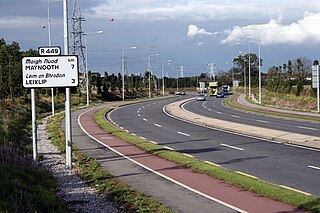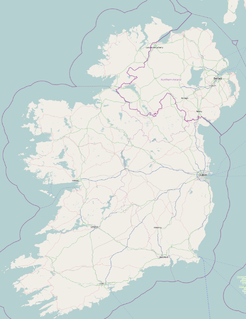
The M1 motorway is a motorway in Ireland. It forms the large majority of the N1 national primary road connecting Dublin towards Belfast along the east of the island of Ireland. The route heads north via Swords, Drogheda and Dundalk to the Northern Irish border just south of Newry in County Armagh, where it joins the A1 road and further on, the M1 motorway in Northern Ireland. It also forms a significant part of the road connection between Dublin and the Northern Irish cities of Newry, and Lisburn. The route is part of European route E01.
The N7 road is a national primary road in Ireland, connecting Limerick and Dublin. The majority of the route is motorway standard and is designated as the M7 motorway. At the Rosbrien interchange in Limerick the route continues as the N18 dual carriage to Shannon and Ennis. The road passes through the midlands of Ireland, and acts as a trunk route out of Dublin for the N8 and N9 national primary routes to Cork and Waterford respectively. It forms part of European route E20.
The N8 road is a national primary road in Ireland, connecting Cork with Dublin via the M7. The road is motorway standard from junction 19 on the M7 to the Dunkettle interchange outside Cork City and is designated as the M8 motorway. From here the route continues into Cork city and terminates at the N22 road at St. Patrick's Street. The M8 motorway was completed in May 2010, replacing the single carriageway sections of the old N8 and bypassing towns on the main Cork to Dublin road. It is now possible to travel from Cork to Dublin on the M/N8 in about 2 hours 30 minutes. The route commences just south of Portlaoise, and reaches Cork via the midlands and the Golden Vale of Ireland, through Counties Laois, Kilkenny, Tipperary, Limerick and Cork. The N8 is further classified by the United Nations as the entirety of the European route E 201.

The National Roads Authority (NRA) was a state body in Ireland, responsible for the national road network. The NRA was established as part of the Roads Act 1993 and commenced operations on 23 December 1993 in accordance with S.I. 407 of 1993. The NRA merged with the Railway Procurement Agency and was effectively dissolved on 1 August 2015. The merger of the two agencies is called Transport Infrastructure Ireland (TII).
The N6 road is a national primary road in Ireland from junction 11 on the M4 motorway at Kinnegad to Galway city. The N6 and N4 form a continuous motorway or dual carriageway from Dublin city centre to Galway City passing in an east–west direction through the midlands of Ireland. Most of the road is motorway standard with the exception of the Athlone bypass and stretches of urban road in Galway City, which are the only sections of the road that remain designated as N6 dual carriageway. There is one toll on the road outside Galway city. Major upgrades to the road were completed in December 2009 completing the first intercity motorway/dual carriageway in Ireland.

The R445 road is a regional road in Ireland. The route is a non-motorway alternative route to the N7/M7 motorway between Naas and Limerick, and at 170 km it is one of the longest regional roads in Ireland. Indeed, much of the route comprises roads that were formerly part of the N7 between the cities, prior to motorway and other bypasses. Some of the R445 route also comprises local link roads to new N7/M7 route sections.
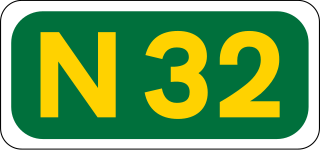
The N32 road was a short national primary road in Ireland running from Junction 3 on the M50, to the Malahide road at Clare Hall. It was effectively a non-motorway section of the M50 Dublin C-Ring, but is only built to primary road status. A short part of the route had motorway restrictions on it as lead to the M1 / M50 interchange, as only motorway traffic can access both routes. In 2013, the road was renumbered as R139.

A High-quality dual carriageway (HQDC) is a category of road in Ireland. It is an all-purpose dual carriageway road type built to near motorway standards, but without motorway classification or motorway restrictions. High-quality dual carriageways have full grade-separated access and do not have junctions with minor roads. Such roads in the Republic of Ireland have been built as part of the 2000-2006 and 2007-2013 National Development Plans, including interurban routes from Dublin to other cities.
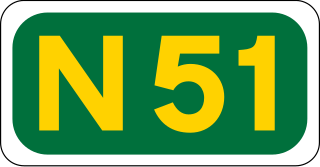
The N51 road is a national secondary road in Ireland. West to east, it starts in Delvin, County Westmeath at a junction with the N52. It passes through Athboy, a junction with M3 motorway, Navan and Slane, where it crosses the N2 road, all in County Meath, before crossing the M1 motorway and terminating near Drogheda in County Louth at a roundabout on the R132.

The N84 road is a national secondary road in Ireland. It is a major route in the West connecting Galway city with Castlebar. The route is of poor quality with a few short good sections in County Mayo between Ballintubber and Ballinrobe. Ballinrobe has become a bottleneck on the route in recent years with up to 8,000 vehicles passing through the town's one-way streets. A bypass for the town is in the planning.
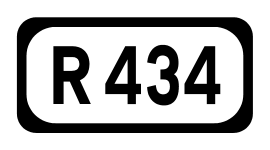
The R434 road is a regional road in Ireland linking Borris-in-Ossory on the R445 to Durrow on the N77. En route it passes through Aghaboe and Ballycolla, and over both the M7 and M8 motorways. The entire route is within County Laois.

The R730 road is a regional road in County Wexford, Ireland. From its junction with the R702 in Kiltealy it takes a southeasterly route to its junction with the R741 in the centre of Wexford Town, continuing south to Blackhorse to its junction on a roundabout with the N25 Wexford bypass.

The R666 road is a regional road in Ireland which runs west-east from the R639 in Fermoy town centre to the bridge over the River Blackwater on the outskirts of Lismore. The road passes through Ballyduff, and beneath the River Blackwater viaduct which carries the M8 motorway. The R666 begins in Fermoy as the Rathhealy Road. From here to its merger with the R667 road 3km south of Kilworth, the R666 was once part of the historic road linking Dublin and Cork. It was mapped as such by Herman Moll in his 1714 New Map of Ireland.

The R692 road is a regional road in Ireland linking Cashel, County Tipperary to Callan, County Kilkenny. It passes through Fethard and Mullinahone en route, and meets the M8 motorway 1km east of Cashel.

The N73 road is a national secondary road in Ireland. It is made up entirely of single carriageway with few overtaking opportunities and only a small amount of hard shoulder.
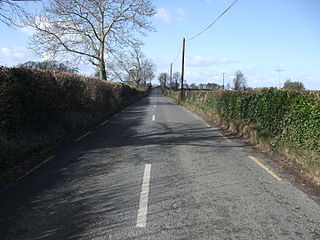
The R670 road is a regional road in Ireland. The route runs from its junction with the R639 and N24 at Cloughabreeda 2 km north of Cahir through Cahir town and onwards for a further 8 km to Ardfinnan, where it joins the R665 road. The R670 is located entirely in County Tipperary.

The R667 road is a regional road in Ireland. The route runs from its junction with the N8 1 km from Kilworth for approximately 5 km until it meets the R666 road northeast of Fermoy. The R667 was once part of the main road from Dublin to Cork, and was mapped as such by Herman Moll in his New Map of Ireland in 1714. The road is located entirely in County Cork.

The R168 road is a regional road in Ireland, linking Drogheda to the N2 at Collon, County Louth.
